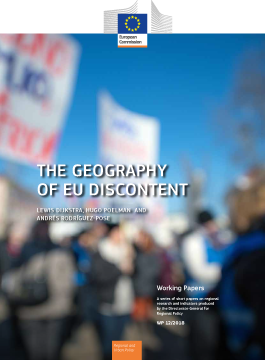The geography of EU discontent

Over the last decade, political parties opposed to EU integration have almost doubled their votes. The general opinion of the EU has also deteriorated, revealing a growing number of people who distrust the Union. To understand this development, this paper focuses on the geography of EU discontent. For the first time, it maps the vote against EU integration in the last national elections across more than 63 000 electoral districts in each of the 28 EU Member States. It assesses whether a range of factors considered to have fostered the surge in populism have had an impact on anti-EU voting. Research into populism often relies on the individual characteristics of anti-system voters: older, working-class, male voters on low incomes and with few qualifications to cope with the challenges of a modern economy. The results show that economic and industrial decline are driving the anti-EU vote. Areas with lower employment rates or with a less-educated workforce are also more likely to vote anti-EU. Once these factors have been taken into account, many of the purported causes of the geography of discontent either matter much less than expected or their impact varies depending on the strength of opposition to the European project.
